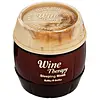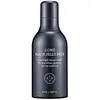What's inside
What's inside
 Key Ingredients
Key Ingredients

 Benefits
Benefits

 Concerns
Concerns

 Ingredients Side-by-side
Ingredients Side-by-side

Water
Skin ConditioningWine Extract
AntioxidantAlcohol
AntimicrobialGlycerin
HumectantButylene Glycol
HumectantPhenoxyethanol
PreservativeRosmarinus Officinalis Extract
AntimicrobialLavandula Angustifolia Extract
Skin ConditioningThymus Vulgaris Extract
PerfumingBergenia Ciliata Root Extract
Skin ConditioningViola Mandshurica Flower Extract
AntioxidantImpatiens Balsamina Flower Extract
AstringentCaprylyl Glycol
EmollientDisodium EDTA
Caprylhydroxamic Acid
Parfum
MaskingGlycereth-26
HumectantAllantoin
Skin ConditioningPEG/PPG/Polybutylene Glycol-8/5/3 Glycerin
HumectantBiosaccharide Gum-1
HumectantHydrogenated Polyisobutene
EmollientPropylene Glycol
HumectantPEG-60 Hydrogenated Castor Oil
EmulsifyingCyclomethicone
EmollientPEG-10 Dimethicone
Skin ConditioningCetyl PEG/PPG-10/1 Dimethicone
EmulsifyingCyclopentasiloxane
EmollientCitrus Limon Fruit Extract
MaskingXanthan Gum
EmulsifyingGlyceryl Polyacrylate
Butylene Glycol Dicaprylate/Dicaprate
EmollientHydrolyzed Wheat Protein/Pvp Crosspolymer
Cyclohexasiloxane
EmollientSaccharum Officinarum Extract
MoisturisingAcer Saccharum Extract
Skin ConditioningCI 15985
Cosmetic ColorantSodium Hyaluronate
HumectantGlyceryl Acrylate/Acrylic Acid Copolymer
HumectantDipropylene Glycol
HumectantDimethicone/Vinyl Dimethicone Crosspolymer
Skin ConditioningSorbitan Sesquioleate
EmulsifyingQuaternium-18 Bentonite
Dimethicone
EmollientNiacinamide
SmoothingAdenosine
Skin ConditioningSodium Chloride
MaskingBis-PEG-18 Methyl Ether Dimethyl Silane
EmollientCI 17200
Cosmetic ColorantCitrus Aurantium Dulcis Fruit Extract
MaskingSilica Dimethyl Silylate
EmollientVaccinium Myrtillus Fruit Extract
Skin ConditioningPEG-240/Hdi Copolymer Bis-Decyltetradeceth-20 Ether
StabilisingTheobroma Cacao Seed Extract
AntioxidantWater, Wine Extract, Alcohol, Glycerin, Butylene Glycol, Phenoxyethanol, Rosmarinus Officinalis Extract, Lavandula Angustifolia Extract, Thymus Vulgaris Extract, Bergenia Ciliata Root Extract, Viola Mandshurica Flower Extract, Impatiens Balsamina Flower Extract, Caprylyl Glycol, Disodium EDTA, Caprylhydroxamic Acid, Parfum, Glycereth-26, Allantoin, PEG/PPG/Polybutylene Glycol-8/5/3 Glycerin, Biosaccharide Gum-1, Hydrogenated Polyisobutene, Propylene Glycol, PEG-60 Hydrogenated Castor Oil, Cyclomethicone, PEG-10 Dimethicone, Cetyl PEG/PPG-10/1 Dimethicone, Cyclopentasiloxane, Citrus Limon Fruit Extract, Xanthan Gum, Glyceryl Polyacrylate, Butylene Glycol Dicaprylate/Dicaprate, Hydrolyzed Wheat Protein/Pvp Crosspolymer, Cyclohexasiloxane, Saccharum Officinarum Extract, Acer Saccharum Extract, CI 15985, Sodium Hyaluronate, Glyceryl Acrylate/Acrylic Acid Copolymer, Dipropylene Glycol, Dimethicone/Vinyl Dimethicone Crosspolymer, Sorbitan Sesquioleate, Quaternium-18 Bentonite, Dimethicone, Niacinamide, Adenosine, Sodium Chloride, Bis-PEG-18 Methyl Ether Dimethyl Silane, CI 17200, Citrus Aurantium Dulcis Fruit Extract, Silica Dimethyl Silylate, Vaccinium Myrtillus Fruit Extract, PEG-240/Hdi Copolymer Bis-Decyltetradeceth-20 Ether, Theobroma Cacao Seed Extract
Water
Skin ConditioningButylene Glycol
HumectantChondrus Crispus Extract
Skin ConditioningSaccharum Officinarum Extract
MoisturisingPhenoxyethanol
PreservativeGlycerin
HumectantNiacinamide
SmoothingPentylene Glycol
Skin ConditioningPEG-240/Hdi Copolymer Bis-Decyltetradeceth-20 Ether
StabilisingPotassium Laurate
EmulsifyingBHT
AntioxidantCarbomer
Emulsion StabilisingPEG-60 Hydrogenated Castor Oil
EmulsifyingOctyldodeceth-16
EmulsifyingCaprylyl Glycol
EmollientAminomethyl Propanol
BufferingAdenosine
Skin ConditioningDisodium EDTA
Pvp
Emulsion StabilisingFullerenes
AntimicrobialHydrolyzed Pearl
Skin ConditioningPalmitoyl Tripeptide-5
Skin ConditioningDipropylene Glycol
HumectantSodium Palmitoyl Proline
Skin ConditioningNymphaea Alba Flower Extract
Skin ConditioningHydrolyzed Hyaluronic Acid
HumectantPlankton Extract
Skin ConditioningParfum
MaskingNigella Sativa Seed Extract
PerfumingRubus Fruticosus Fruit Extract
AstringentRibes Nigrum Leaf Extract
PerfumingPropolis Extract
Skin ConditioningTuber Melanosporum Extract
HumectantAureobasidium Pullulans Ferment
Skin ConditioningGardenia Florida Fruit Extract
Skin ConditioningMonascus Extract
Skin ConditioningMaltodextrin
AbsorbentCarthamus Tinctorius Flower Extract
Skin ConditioningWater, Butylene Glycol, Chondrus Crispus Extract, Saccharum Officinarum Extract, Phenoxyethanol, Glycerin, Niacinamide, Pentylene Glycol, PEG-240/Hdi Copolymer Bis-Decyltetradeceth-20 Ether, Potassium Laurate, BHT, Carbomer, PEG-60 Hydrogenated Castor Oil, Octyldodeceth-16, Caprylyl Glycol, Aminomethyl Propanol, Adenosine, Disodium EDTA, Pvp, Fullerenes, Hydrolyzed Pearl, Palmitoyl Tripeptide-5, Dipropylene Glycol, Sodium Palmitoyl Proline, Nymphaea Alba Flower Extract, Hydrolyzed Hyaluronic Acid, Plankton Extract, Parfum, Nigella Sativa Seed Extract, Rubus Fruticosus Fruit Extract, Ribes Nigrum Leaf Extract, Propolis Extract, Tuber Melanosporum Extract, Aureobasidium Pullulans Ferment, Gardenia Florida Fruit Extract, Monascus Extract, Maltodextrin, Carthamus Tinctorius Flower Extract
Ingredients Explained
These ingredients are found in both products.
Ingredients higher up in an ingredient list are typically present in a larger amount.
Adenosine is in every living organism. It is one of four components in nucleic acids that helps store our DNA.
Adenosine has many benefits when used. These benefits include hydrating the skin, smoothing skin, and reducing wrinkles. Once applied, adenosine increases collagen production. It also helps with improving firmness and tissue repair.
Studies have found adenosine may also help with wound healing.
In skincare products, Adenosine is usually derived from yeast.
Learn more about AdenosineButylene Glycol (or BG) is used within cosmetic products for a few different reasons:
Overall, Butylene Glycol is a safe and well-rounded ingredient that works well with other ingredients.
Though this ingredient works well with most skin types, some people with sensitive skin may experience a reaction such as allergic rashes, closed comedones, or itchiness.
Learn more about Butylene GlycolCaprylyl Glycol is a humectant and emollient, meaning it attracts and preserves moisture.
It is a common ingredient in many products, especially those designed to hydrate skin. The primary benefits are retaining moisture, skin softening, and promoting a healthy skin barrier.
Though Caprylyl Glycol is an alcohol derived from fatty acids, it is not the kind that can dry out skin.
This ingredient is also used as a preservative to extend the life of products. It has slight antimicrobial properties.
Learn more about Caprylyl GlycolDipropylene Glycol is a synthetically created humectant, stabilizer, and solvent.
This ingredient helps:
Dipropylene glycol is technically an alcohol, but it belongs to the glycol family (often considered part of the ‘good’ alcohols). This means it is hydrating and gentle on skin unlike drying solvent alcohols like denatured alcohol.
As a masking agent, Dipropylene Glycol can be used to cover the smell of other ingredients. However, it does not have a scent.
Studies show Dipropylene Glycol is considered safe to use in skincare.
Learn more about Dipropylene GlycolDisodium EDTA plays a role in making products more stable by aiding other preservatives.
It is a chelating agent, meaning it neutralizes metal ions that may be found in a product.
Disodium EDTA is a salt of edetic acid and is found to be safe in cosmetic ingredients.
Learn more about Disodium EDTAGlycerin is already naturally found in your skin. It helps moisturize and protect your skin.
A study from 2016 found glycerin to be more effective as a humectant than AHAs and hyaluronic acid.
As a humectant, it helps the skin stay hydrated by pulling moisture to your skin. The low molecular weight of glycerin allows it to pull moisture into the deeper layers of your skin.
Hydrated skin improves your skin barrier; Your skin barrier helps protect against irritants and bacteria.
Glycerin has also been found to have antimicrobial and antiviral properties. Due to these properties, glycerin is often used in wound and burn treatments.
In cosmetics, glycerin is usually derived from plants such as soybean or palm. However, it can also be sourced from animals, such as tallow or animal fat.
This ingredient is organic, colorless, odorless, and non-toxic.
Glycerin is the name for this ingredient in American English. British English uses Glycerol/Glycerine.
Learn more about GlycerinNiacinamide is a multitasking form of vitamin B3 that strengthens the skin barrier, reduces pores and dark spots, regulates oil, and improves signs of aging.
And the best part? It's gentle and well-tolerated by most skin types, including sensitive and reactive skin.
You might have heard of "niacin flush", or the reddening of skin that causes itchiness. Niacinamide has not been found to cause this.
In very rare cases, some individuals may not be able to tolerate niacinamide at all or experience an allergic reaction to it.
If you are experiencing flaking, irritation, and dryness with this ingredient, be sure to double check all your products as this ingredient can be found in all categories of skincare.
When incorporating niacinamide into your routine, look out for concentration amounts. Typically, 5% niacinamide provides benefits such as fading dark spots. However, if you have sensitive skin, it is better to begin with a smaller concentration.
When you apply niacinamide to your skin, your body converts it into nicotinamide adenine dinucleotide (NAD). NAD is an essential coenzyme that is already found in your cells as "fuel" and powers countless biological processes.
In your skin, NAD helps repair cell damage, produce new healthy cells, support collagen production, strengthen the skin barrier, and fight environmental stressors (like UV and pollution).
Our natural NAD levels start to decline with age, leading to slower skin repair, visible aging, and a weaker skin barrier. By providing your skin niacinamide, you're recharging your skin's NAD levels. This leads to stronger, healthier, and younger looking skin.
Another name for vitamin B3 is nicotinamide. This vitamin is water-soluble and our bodies don't store it. We obtain Vitamin B3 from either food or skincare. Meat, fish, wheat, yeast, and leafy greens contain vitamin B3.
The type of niacinamide used in skincare is synthetically created.
Learn more about NiacinamideParfum is a catch-all term for an ingredient or more that is used to give a scent to products.
Also called "fragrance", this ingredient can be a blend of hundreds of chemicals or plant oils. This means every product with "fragrance" or "parfum" in the ingredients list is a different mixture.
For instance, Habanolide is a proprietary trade name for a specific aroma chemical. When used as a fragrance ingredient in cosmetics, most aroma chemicals fall under the broad labeling category of “FRAGRANCE” or “PARFUM” according to EU and US regulations.
The term 'parfum' or 'fragrance' is not regulated in many countries. In many cases, it is up to the brand to define this term.
For instance, many brands choose to label themselves as "fragrance-free" because they are not using synthetic fragrances. However, their products may still contain ingredients such as essential oils that are considered a fragrance by INCI standards.
One example is Calendula flower extract. Calendula is an essential oil that still imparts a scent or 'fragrance'.
Depending on the blend, the ingredients in the mixture can cause allergies and sensitivities on the skin. Some ingredients that are known EU allergens include linalool and citronellol.
Parfum can also be used to mask or cover an unpleasant scent.
The bottom line is: not all fragrances/parfum/ingredients are created equally. If you are worried about fragrances, we recommend taking a closer look at an ingredient. And of course, we always recommend speaking with a professional.
Learn more about ParfumWe don't have a description for PEG-240/Hdi Copolymer Bis-Decyltetradeceth-20 Ether yet.
Peg-60 Hydrogenated Castor Oil comes from hydrogenated castor oil. It is a solubilizer and emulsifier.
As a solubilizer, it helps dissolve ingredients into a water-based version. It is also an emulsifer. Emulsifier help prevent oils and water from separating. Both these properties help create evenly-spread and uniform products.
Basically, Peg-60 Hydrogenated Castor Oil helps hold ingredients together.
Learn more about PEG-60 Hydrogenated Castor OilPhenoxyethanol is a preservative that has germicide, antimicrobial, and aromatic properties. Studies show that phenoxyethanol can prevent microbial growth. By itself, it has a scent that is similar to that of a rose.
It's often used in formulations along with Caprylyl Glycol to preserve the shelf life of products.
This ingredient is also called sugarcane extract. It is a moisturizing humectant and has skin soothing properties.
Similar to hyaluronic acid, sugarcane can attract moisture to your skin.
Glycolic acid is a derivative of sugarcane. While glycolic acid is an AHA with exfoliating properties, sugarcane is not an AHA.
A study from 2021 found the compounds in sugarcane extract to have antioxidant, antimicrobial, and anti-inflammatory activity. The study also suggests these compounds can inhibit skin ageing enzymes and promote collagen synthesis.
Learn more about Saccharum Officinarum ExtractWater. It's the most common cosmetic ingredient of all. You'll usually see it at the top of ingredient lists, meaning that it makes up the largest part of the product.
So why is it so popular? Water most often acts as a solvent - this means that it helps dissolve other ingredients into the formulation.
You'll also recognize water as that liquid we all need to stay alive. If you see this, drink a glass of water. Stay hydrated!
Learn more about Water